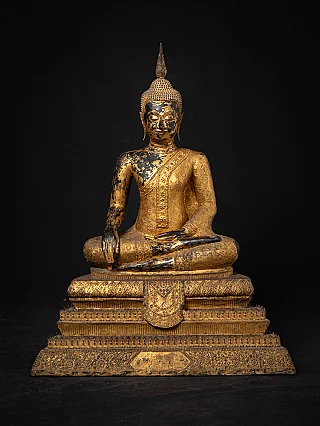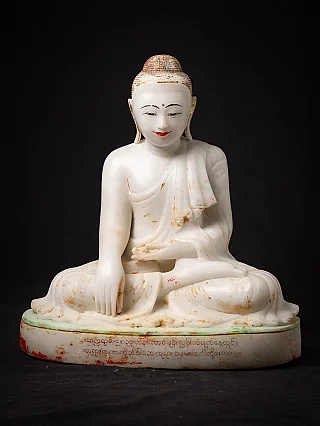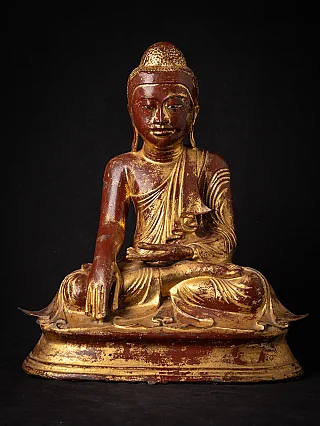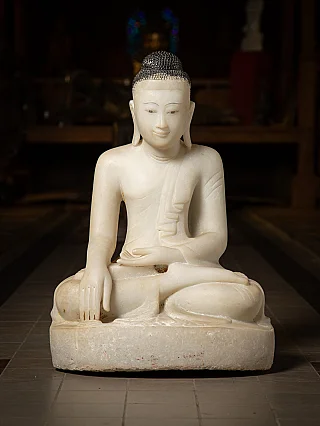Bhumisparsha Mudra

See our Buddha statues in Bhumisparsha Mudra
Bhumisparsha Mudra, known as the "Earth Witness Gesture," is one of Buddhist iconography's most profound and recognizable hand gestures. This mudra captures the pivotal moment in the Buddha's journey to enlightenment when he called upon the Earth to witness his triumph over the temptations and distractions of Mara, the demon of illusion. The gesture is symbolized by the right hand touching the ground, with the left hand resting in the lap, palm facing upwards.
The Significance of Bhumisparsha Mudra

Bhumisparsha Mudra holds deep symbolic meaning within Buddhism. It represents:
- The Moment of Enlightenment: This mudra symbolized when Siddhartha Gautama attained enlightenment under the Bodhi tree. The Buddha invoked the Earth Goddess to witness his victory over Mara by touching the Earth.
- Unshakable Resolve: The gesture signifies the Buddha's unwavering determination and focus when facing distractions and challenges.
- Connection to the Earth: It emphasizes the grounding and stabilizing power of the Earth, reflecting the Buddha's deep connection to the natural world.
Historical Background
The Bhumisparsha Mudra is deeply rooted in Siddhartha Gautama's life story. According to Buddhist tradition, as Siddhartha meditated under the Bodhi tree, he was confronted by Mara, who sought to distract him and prevent his enlightenment. In response, Siddhartha reached out his right hand to touch the Earth, calling upon it to witness his past virtuous deeds. The Earth Goddess responded, acknowledging his worthiness and dispelling Mara and his forces.
Iconography and Representation
In Buddhist art, Bhumisparsha Mudra is depicted with the following characteristics:
- Right Hand: The right-hand reaches down towards the Earth, extending fingers and touching the ground.
- Left Hand: The left-hand rests on the lap, palm facing upwards meditatively.
- Seated Position: The Buddha is often shown sitting in the lotus position, symbolizing stability and inner peace.
This gesture is commonly found in statues and paintings of the Buddha across various cultures and traditions, including Thai, Burmese, and Tibetan art, where it serves as a visual testament to the Buddha's enlightenment and spiritual victory.
Spiritual and Cultural Significance
Bhumisparsha Mudra is not just an artistic symbol; it carries profound spiritual significance:
- Affirmation of Enlightenment: For practitioners, this mudra is a powerful reminder of the Buddha's enlightenment and the possibility of achieving a similar spiritual awakening.
- Symbol of Truth: It underscores the importance of truth and integrity, as the Earth bears witness to the Buddha's truthfulness and moral purity.
- Source of Inspiration: The gesture inspires followers to remain steadfast in their spiritual practice, regardless of obstacles.
Bhumisparsha Mudra in Buddhist Practice

Meditation and Mindfulness
In Buddhist practice, Bhumisparsha Mudra is often used during meditation sessions. The gesture is a physical reminder to stay grounded and connected to the Earth, promoting stability and calm. Practitioners believe that by adopting this mudra, they can channel the Buddha's determination and clarity, helping them to overcome mental distractions and achieve deeper states of meditation.
Symbolism in Temples and Monasteries
Buddhist temples and monasteries frequently feature statues of the Buddha in Bhumisparsha Mudra. These statues serve as focal points for worship and contemplation, reminding visitors and monks alike of the Buddha's journey to enlightenment. The presence of this mudra in sacred spaces reinforces the values of truth, resolve, and spiritual triumph.
Frequently Asked Questions
What is the meaning of Bhumisparsha Mudra?
Bhumisparsha Mudra means "Earth Witness Gesture." It represents when the Buddha called upon the Earth to witness his enlightenment.
Why did the Buddha touch the Earth?
The Buddha touched the Earth to call upon it as a witness to his past virtuous deeds and to affirm his worthiness of enlightenment, thereby overcoming the distractions and temptations posed by Mara.
Where is Bhumisparsha Mudra commonly depicted?
This mudra is frequently depicted in Buddhist art, including statues and paintings, particularly in regions with a strong Buddhist heritage, such as Thailand, Myanmar (Burma), and Tibet.
How does Bhumisparsha Mudra inspire modern practitioners?
For modern practitioners, Bhumisparsha Mudra symbolizes steadfastness and truth. It encourages individuals to remain grounded and resolute in their spiritual journey despite challenges and distractions.
Can Bhumisparsha Mudra be used in personal meditation?
Yes, it can foster a sense of grounding and stability. It helps practitioners focus their minds and connect with the Earth, enhancing their meditation practice.
Conclusion
Bhumisparsha Mudra is a powerful and evocative symbol in Buddhism. It represents the Buddha's enlightenment and his connection to the Earth. Its depiction in Buddhist art is a constant reminder of the values of truth, determination, and spiritual awakening. For practitioners and admirers of Buddhist culture alike, this mudra offers profound inspiration and insight into the Buddha's journey and teachings.
By understanding and embracing the significance of Bhumisparsha Mudra, we can draw inspiration from the Buddha's example and apply these timeless principles to our lives. Whether through meditation, art, or daily practice, this mudra encourages us to remain grounded, truthful, and steadfast on our path to spiritual growth.
Share this page















































